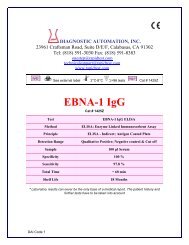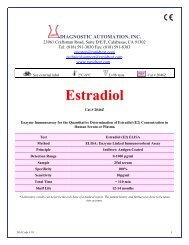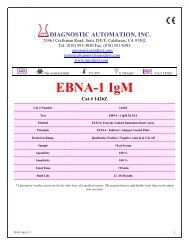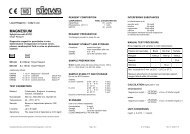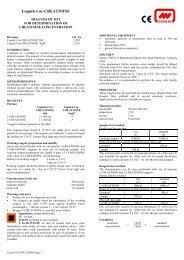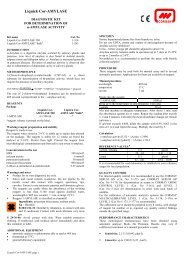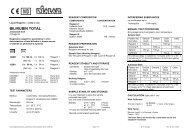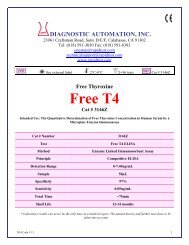CORMAY VDRL
CORMAY VDRL
CORMAY VDRL
Create successful ePaper yourself
Turn your PDF publications into a flip-book with our unique Google optimized e-Paper software.
<strong>CORMAY</strong> <strong>VDRL</strong><br />
CONFIRMING HAEMAGGLUTINATION TEST<br />
FOR DETECTION OF<br />
PLASMA REAGINS<br />
Kit name Kit size Cat. No<br />
<strong>CORMAY</strong> <strong>VDRL</strong> 250 250 tests 6-257<br />
<strong>CORMAY</strong> <strong>VDRL</strong> 1500 1500 tests 6-258<br />
INTRODUCTION<br />
Reagins are a group of antibodies against some components of the<br />
damage tissues from patients infected by Treponema pallidum, the<br />
agent which causes the syphilis. This microorganism produces some<br />
damage to the liver and heart, releasing some tissue fragments.<br />
Immunological patient system reacts producing reagins-antibodies<br />
against these fragments. Determination of plasma reagins is nonspecific<br />
test for diagnosis of Treponema pallidum and is useful to<br />
follow up the antibiotic therapy.<br />
METHOD PRINCIPLE<br />
The antigen suspension, a lipid complex (cardiolipin, lecithin,<br />
cholesterol), is agglutinated when mixed with samples containing<br />
reagins.<br />
REAGENTS<br />
Package<br />
<strong>CORMAY</strong><br />
<strong>VDRL</strong> 250<br />
<strong>CORMAY</strong><br />
<strong>VDRL</strong> 1500<br />
<strong>VDRL</strong>- stabilized Antigen 1 x 5 ml 1 x 30 ml<br />
<strong>VDRL</strong>-Control (+) (red cap) 1 x 1 ml 1 x 1 ml<br />
<strong>VDRL</strong>-Control (-) (blue cap) 1 x 1 ml 1 x 1 ml<br />
The reagents when stored at 2-8°C are stable up to expiry date<br />
printed on the package. Keep vials in vertical position. If the<br />
position is changed, gently mix to dissolve aggregates that may be<br />
present. Do not freeze. Avoid contamination!<br />
Preparation:<br />
The reagents are ready to use.<br />
Concentrations in the test<br />
cardiolipin<br />
lecithin<br />
cholesterol<br />
phosphate buffer pH 7.0<br />
artificial serum solution<br />
animal serum solution<br />
preservatives<br />
0.3 g/l<br />
2.1 g/l<br />
9.0 g/l<br />
1.5 mmol/l<br />
Warnings and notes<br />
Product for in vitro diagnostic use only.<br />
The reagents must be used only for the purpose intended by<br />
suitably qualified laboratory personnel, under appropriate<br />
laboratory conditions.<br />
<strong>CORMAY</strong> <strong>VDRL</strong> test is non-specific for syphilis. All reactive<br />
samples should be retested with treponemic methods such as<br />
TPHA and FTA-Abs to confirm the results.<br />
A negative result does not exclude infection of Treponema<br />
pallidum.<br />
False positive results have been reported in diseases such as<br />
infectious mononucleosis, viral pneumonia, toxoplasmosis,<br />
pregnancy and autoimmune diseases.<br />
Diagnosis should only be made after taking clinical symptoms<br />
and the results of other tests into consideration.<br />
SPECIMEN<br />
Serum, plasma or cerebrospinal fluid. Stable 7 days at 2-8ºC or<br />
3 months at -20ºC.<br />
The samples with presence of fibrin should be centrifuged before use.<br />
Do not use highly hemolized or lipemic samples.<br />
PROCEDURE<br />
The test is recommended for the qualitative and semi-quantitative<br />
manual assay.<br />
Qualitative method<br />
1. Allow the reagents and samples to reach room temperature. The<br />
sensitivity of the test may be reduced at low temperatures.<br />
2. Place 50 µl of the sample and one drop of each positive and<br />
negative controls into separate circles on the slide test.<br />
3. Swirl the <strong>VDRL</strong> suspension gently before using and add one drop<br />
(20 µl) next to the sample to be tested.<br />
4. Place the slide on a mechanical rotator at 180 r.p.m. for 4<br />
minutes. False positive results could appear if the test is read later<br />
than four minutes.<br />
Reading and interpretation<br />
Examine the presence or absence of agglutination immediately after<br />
rotation using the light microscope.<br />
The presence of agglutination indicates of plasma reagins.<br />
Semi-quantitative method<br />
1. Make serial two fold dilutions of the sample in 0.9% NaCl<br />
solution.<br />
2. Proceed for each dilution as in the qualitative method.<br />
Reading and interpretation<br />
The result (titer), in the semi-quantitative method, is defined as the<br />
highest dilution showing a positive result.<br />
QUALITY CONTROL<br />
Positive and negative controls are recommended to monitor the<br />
performance of the procedure, as well as a comparative pattern for a<br />
better result interpretation.<br />
Any result different from negative control result will be considered<br />
as positive.<br />
PERFORMANCE CHARACTERISTICS<br />
Analytical sensitivity: according with recommendations of<br />
CDC.<br />
Prozone effect: no prozone effect up to titers ≥ 1/128.<br />
<br />
Diagnostic sensitivity: 100 %.<br />
Diagnostic specificity: 100 %.<br />
<br />
Interferences:<br />
Haemoglobin up to 10 g/l, bilirubin up to 20 mg/dl, triglycerides<br />
up to 10 g/l and RF up to 300 IU/ml do not interfere with the<br />
test.<br />
WASTE MANAGEMENT<br />
Please refer to local legal requirements.<br />
ADDITIONAL EQUIPMENT<br />
mechanical rotator with adjustable speed at 180 r.p.m.;<br />
glass slides;<br />
light microscope (100x);<br />
pipettes 50 µl<br />
general laboratory equipment.<br />
<strong>CORMAY</strong> <strong>VDRL</strong> page 1
LITERATURE<br />
1. George P. Schimid. Current Opinion in Infectious Diseases 1994;<br />
7: 34-40.<br />
2. Sandra A Larsen et al. Clinical Microbiology Reviews 1995; 8 (1):<br />
1-21.<br />
3. Sandra Larsen et al. A manual of Test for Syphilis American<br />
Public Health Association 1990: 1-192.<br />
4. Young DS. Effects of drugs on clinical laboratory test, 4th ed.<br />
AACC Press, 1995.<br />
Date of issue: 09. 2013.<br />
MANUFACTURER<br />
PZ <strong>CORMAY</strong> S.A.<br />
22 Wiosenna Street,<br />
05-092 Łomianki, POLAND<br />
tel.: +48 (0) 22 751 79 10<br />
fax: +48 (0) 22 751 79 14<br />
http://www.cormay.pl<br />
09/13/09/13<br />
<strong>CORMAY</strong> <strong>VDRL</strong> page 2






